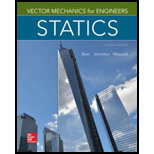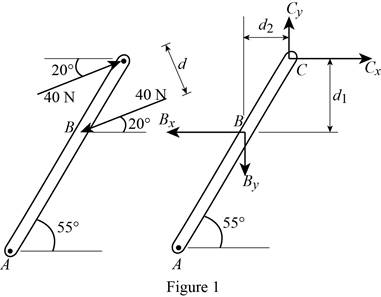
(a)
Find the moment of the couple (M) formed by two forces by resolving each force into horizontal and vertical components and adding the moments of the two resulting couples.
(a)
Answer to Problem 3.71P
The moment of the couple (M) formed by two forces by resolving each force into horizontal and vertical components and adding the moments of the two resulting couples is
Explanation of Solution
Given information:
The applied force at point B
The applied force at point C
The length of AB (x) is 390 mm.
The length of BC (y) is 270 mm.
The angle of the inclined lever
The angle of the force acting at point C
Calculation:
Show the free body diagram of the lever as Figure 1.

Calculate the vertical height of BC
Substitute 270 mm for y and
Calculate the horizontal height of BC
Substitute 270 mm for y and
Calculate the horizontal reaction at C
Substitute 40 N for
Calculate the vertical reaction at C
Substitute 40 N for
Take the moment about B.
Substitute 0.22117 m for
Therefore, the moment of the couple (M) formed by two forces by resolving each force into horizontal and vertical components and adding the moments of the two resulting couples is
(b)
Find the moment of the couple (M) formed by two forces by using the perpendicular distance between the two forces.
(b)
Answer to Problem 3.71P
The moment of the couple (M) formed by two forces by using the perpendicular distance between the two forces is
Explanation of Solution
Given information:
The applied force at point B
The applied force at point C
The length of AB (x) is 390 mm.
The length of BC (y) is 270 mm.
The angle of the inclined lever
The angle of the force acting at point C
Calculation:
Calculate the distance (d) between the two forces using the relation:
Substitute 270 mm for y,
Calculate the moment of the couple (M) formed by two forces by using the perpendicular distance between the two forces using the relation:
Substitute 40 N for F and 0.154866 m for d.
Therefore, the moment of the couple (M) formed by two forces by using the perpendicular distance between the two forces is
(c)
Find the moment of the couple (M) formed by summing the moments of two forces about point A.
(c)
Answer to Problem 3.71P
The moment of the couple (M) formed by summing the moments of two forces about point A is
Explanation of Solution
Given information:
The applied force at point B
The applied force at point C
The length of AB (x) is 390 mm.
The length of BC (y) is 270 mm.
The angle of the inclined lever
The angle of the force acting at point C
Calculation:
Calculate the position vector of from point B to point A
Substitute 390 mm for x and
Calculate the force at B by resolving in horizontal and vertical direction using the relation:
Substitute 40 N for
Calculate the position vector of from point C to point A
Substitute 390 mm for x, 270 mm for y and
Calculate the force at C by resolving in horizontal and vertical direction using the relation:
Substitute 40 N for
Calculate the moment of the couple (M) formed by summing the moments of two forces about point A using the relation:
Take the moment about A.
Substitute
Therefore, the moment of the couple (M) formed by summing the moments of two forces about point A is
Want to see more full solutions like this?
Chapter 3 Solutions
Vector Mechanics for Engineers: Statics, 11th Edition
- (read image) (answer given)arrow_forward11-5. Compute all the dimensional changes for the steel bar when subjected to the loads shown. The proportional limit of the steel is 230 MPa. 265 kN 100 mm 600 kN 25 mm thickness X Z 600 kN 450 mm E=207×103 MPa; μ= 0.25 265 kNarrow_forwardT₁ F Rd = 0.2 m md = 2 kg T₂ Tz1 Rc = 0.4 m mc = 5 kg m = 3 kgarrow_forward
- 2. Find a basis of solutions by the Frobenius method. Try to identify the series as expansions of known functions. (x + 2)²y" + (x + 2)y' - y = 0 ; Hint: Let: z = x+2arrow_forward1. Find a power series solution in powers of x. y" - y' + x²y = 0arrow_forward3. Find a basis of solutions by the Frobenius method. Try to identify the series as expansions of known functions. 8x2y" +10xy' + (x 1)y = 0 -arrow_forward
- Hello I was going over the solution for this probem and I'm a bit confused on the last part. Can you please explain to me 1^4 was used for the Co of the tubular cross section? Thank you!arrow_forwardBlood (HD = 0.45 in large diameter tubes) is forced through hollow fiber tubes that are 20 µm in diameter.Equating the volumetric flowrate expressions from (1) assuming marginal zone theory and (2) using an apparentviscosity for the blood, estimate the marginal zone thickness at this diameter. The viscosity of plasma is 1.2 cParrow_forwardQ2: Find the shear load on bolt A for the connection shown in Figure 2. Dimensions are in mm Fig. 2 24 0-0 0-0 A 180kN (10 Markarrow_forward
- determine the direction and magnitude of angular velocity ω3 of link CD in the four-bar linkage using the relative velocity graphical methodarrow_forwardFour-bar linkage mechanism, AB=40mm, BC=60mm, CD=70mm, AD=80mm, =60°, w1=10rad/s. Determine the direction and magnitude of w3 using relative motion graphical method. A B 2 3 77777 477777arrow_forwardFour-bar linkage mechanism, AB=40mm, BC=60mm, CD=70mm, AD=80mm, =60°, w1=10rad/s. Determine the direction and magnitude of w3 using relative motion graphical method. A B 2 3 77777 477777arrow_forward
 Elements Of ElectromagneticsMechanical EngineeringISBN:9780190698614Author:Sadiku, Matthew N. O.Publisher:Oxford University Press
Elements Of ElectromagneticsMechanical EngineeringISBN:9780190698614Author:Sadiku, Matthew N. O.Publisher:Oxford University Press Mechanics of Materials (10th Edition)Mechanical EngineeringISBN:9780134319650Author:Russell C. HibbelerPublisher:PEARSON
Mechanics of Materials (10th Edition)Mechanical EngineeringISBN:9780134319650Author:Russell C. HibbelerPublisher:PEARSON Thermodynamics: An Engineering ApproachMechanical EngineeringISBN:9781259822674Author:Yunus A. Cengel Dr., Michael A. BolesPublisher:McGraw-Hill Education
Thermodynamics: An Engineering ApproachMechanical EngineeringISBN:9781259822674Author:Yunus A. Cengel Dr., Michael A. BolesPublisher:McGraw-Hill Education Control Systems EngineeringMechanical EngineeringISBN:9781118170519Author:Norman S. NisePublisher:WILEY
Control Systems EngineeringMechanical EngineeringISBN:9781118170519Author:Norman S. NisePublisher:WILEY Mechanics of Materials (MindTap Course List)Mechanical EngineeringISBN:9781337093347Author:Barry J. Goodno, James M. GerePublisher:Cengage Learning
Mechanics of Materials (MindTap Course List)Mechanical EngineeringISBN:9781337093347Author:Barry J. Goodno, James M. GerePublisher:Cengage Learning Engineering Mechanics: StaticsMechanical EngineeringISBN:9781118807330Author:James L. Meriam, L. G. Kraige, J. N. BoltonPublisher:WILEY
Engineering Mechanics: StaticsMechanical EngineeringISBN:9781118807330Author:James L. Meriam, L. G. Kraige, J. N. BoltonPublisher:WILEY





